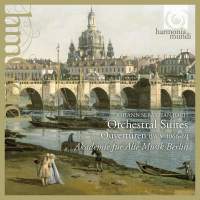Texte paru dans: / Appeared in: |
|
|
Reviewer: Brian
Robins On the evidence of these exceptionally fine performances Harmonia Mundi has made an astute move in signing an exclusive contract with the Akademie für Alte Musik Berlin (henceforth AAMB), the period-instrument group founded in 1982 in what was then East Berlin. Listening to these profoundly satisfying interpretations one is left in no doubt of the care that has been taken in their preparation by the conductorless ensemble, whose playing to my mind encompasses all facets of the best in German Bach playing. The sheer sound of the AAMB (and throughout they have been given a recording of outstanding quality) is itself worth comment, for there is an impressive depth founded on a sonorous and clearly etched bass line, and warm but beautifully articulated playing from the upper strings. Yet line is never employed at the expense of clarity in inner parts being sacrificed, sonority never achieved at the cost of losing vital rhythmic impulse. This successful integration of the linear and the vertical increasingly seems to me the secret of great Bach interpretation. That might sound like a truism, but in fact it is something rarely encountered—indeed among present-day Bach conductors only Philippe Herreweghe can be regularly relied upon to achieve such a synthesis. A further major asset of the present performances is a total lack of idiosyncrasy either in matters of style or tempo. And, no, that is not a euphemism for saying they lack character, for the reverse is very much the case, as the juxtaposition of B-Minor flute suite and No. 4 on the same disc dramatically proves. As seems to have become customary, the former is given with one string per part, but even allowing for this it is an unusually intimate reading, with the flute (flawlessly played by Ernst-Burghard Hilse) much more part of the instrumental texture than we normally hear, something I'm sure Bach intended. In contrast BWV 1069 opens with an overture of impressive weight, resplendent in its display of brilliant ceremonial pomp and splendor—the interjections from timpani and trumpets are truly thrilling. The tempos of the dance movements in all the suites strike a near-perfect balance; it is remarkable how frequently they fall near-midway between those of Eliot Gardiner and Pinnock, two of my benchmark versions in these works. Neither has the French derivation of these movements been overlooked, and one might particularly cite the Menuets for their pointed elegance, and the infectious verve of the light, fast Bourrées. Having listened to these performances several times, I'm in little doubt that although there cannot be a “best buy“ for a group of works that have fared unusually well on disc, these immensely musical and gratifying interpretations take their place at the top of the pile. At present I have a strong suspicion it may well be the set that comes off the shelf most frequently, for it is one that will surely stand the test of repeated listening more than most. | |
|
|
|
|
|
|
|
Cliquez l'un ou l'autre
bouton pour découvrir bien d'autres critiques de CD |
|



